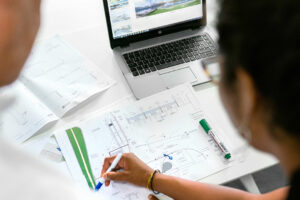The imperatives of sustainable buildings and infrastructure in the Philippines
The Philippines is a country with a growing population and a rapidly developing economy. As the country continues to grow, there is a growing need for sustainable buildings and infrastructure. Sustainable buildings and infrastructure are designed to reduce their environmental impact and improve the quality of life for the people who use them. There are […]

The Philippines is a country with a growing population and a rapidly developing economy. As the country continues to grow, there is a growing need for sustainable buildings and infrastructure. Sustainable buildings and infrastructure are designed to reduce their environmental impact and improve the quality of life for the people who use them.
There are many different ways to make a building more sustainable. Some of the most common strategies include:
• Using renewable energy sources: Sustainable buildings can be powered by solar, wind, or other renewable energy sources. This can help to reduce the building’s reliance on fossil fuels and its contribution to climate change.
• Efficient water use: Sustainable buildings can be designed to use less water. This can be done by using water-efficient fixtures and appliances, rainwater harvesting, and greywater recycling.
• Energy efficiency: Sustainable buildings can be designed to be energy efficient. This can be done by using insulation, energy-efficient lighting, and other energy-saving measures.
• Sustainable materials: Sustainable buildings can be made from recycled materials or materials that are grown or harvested sustainably. This can help to reduce the building’s environmental impact and its contribution to deforestation and other environmental problems.
• Healthy indoor environment: Sustainable buildings can be designed to create a healthy indoor environment for occupants. This can be done by using natural ventilation, low-emitting materials, and other strategies that improve air quality and reduce exposure to harmful pollutants.
Sustainable buildings are becoming increasingly popular. There are now many different types of sustainable buildings available, from small homes to large office buildings. As the demand for sustainable buildings grows, the cost of building sustainably is decreasing. This makes sustainable buildings a more affordable option for both businesses and homeowners.
Indeed, the future of architecture is sustainable. As the world becomes more aware of the need to protect the environment, sustainable buildings will become increasingly common.
Sustainable buildings offer several benefits and some of the most common benefits include:
• Reduced environmental impact: Sustainable buildings and infrastructure can help to reduce greenhouse gas emissions, conserve water, and protect natural resources.
• Improved quality of life: Sustainable buildings and infrastructure can provide a healthier and more comfortable environment for people who live and work in them.
• Economic benefits: Sustainable buildings and infrastructure can create jobs, boost the economy, and attract investment.
• Increased property value: Sustainable buildings often command a higher price on the real estate market. This is because buyers are increasingly looking for homes and offices that are environmentally friendly.
• Enhanced employee morale: Employees who work in sustainable buildings are often more satisfied with their jobs and have higher morale. This is because they appreciate the fact that their employer is taking steps to protect the environment.
• Improved public image: Businesses that build sustainable buildings can improve their public image and attract new customers. This is because consumers are increasingly looking to do business with companies that are committed to sustainability.
Examples of sustainable buildings and infrastructure in the Philippines abound. Among the most notable ones are:
• The Zuellig Building: The Zuellig Building is a LEED Platinum-certified office building in Makati City. It features a number of sustainable features, including rainwater harvesting, solar panels, and a green roof.
• The Pioneer House CDO: The Pioneer House CDO is a LEED Platinum-certified office building in Cagayan de Oro City. It features a number of sustainable features, including natural ventilation, energy-efficient lighting, and water-saving fixtures.
• The ArthaLand Century Pacific Tower: The ArthaLand Century Pacific Tower is a LEED Gold-certified office building in Taguig City. It features a number of sustainable features, including a green roof, rainwater harvesting, and energy-efficient lighting.
• SM Aura Premier: SM Aura Premier is a LEED Gold-certified shopping mall in Taguig City. It features a number of sustainable features, including a green roof, rainwater harvesting, and energy-efficient lighting.
• The Manila Baywalk Tunnel: The Manila Baywalk Tunnel is a sustainable infrastructure project that was completed in 2018. The tunnel helps to reduce traffic congestion and improve air quality in the area.
There are some challenges to building sustainable buildings and infrastructure in the Philippines. These include the following:
• High cost: Sustainable buildings and infrastructure can be more expensive to build than traditional buildings and infrastructure. This is because sustainable materials and technologies can be more expensive than conventional materials and technologies.
• Lack of awareness: There is a lack of awareness about the benefits of sustainable buildings and infrastructure among the public and decision-makers. This can make it difficult to get support for sustainable projects.
• Lack of skilled labor: There is a lack of labor in the Philippines with the skills needed to build sustainable buildings and infrastructure. This can make it difficult to find contractors and suppliers who can build sustainable projects.
Despite these challenges, the Philippines has several initiatives to promote the development of sustainable buildings and infrastructure in the country. For one, the Philippines has several policies and programs in place to promote sustainable buildings and infrastructure. These policies and programs include:
• The Philippine Green Building Code: The Philippine Green Building Code is a set of standards for the design, construction, and operation of green buildings.
• The Sustainable Infrastructure Financing Facility: The Sustainable Infrastructure Financing Facility is a program that provides financial assistance for sustainable infrastructure projects.
• The Green Investment Program: The Green Investment Program is a program that provides tax incentives for businesses that invest in sustainable infrastructure.
However, there is still more that needs to be done to encourage the development of sustainable buildings and infrastructure. Some of the policies that could be implemented include:
• Financial incentives: The government could provide financial incentives, such as tax breaks and grants, to businesses and individuals who build sustainable buildings and infrastructure.
• Regulations: The government could implement regulations that require new buildings and infrastructure to meet certain sustainability standards.
• Providing training: The government can provide training to workers in the construction industry so that they can develop the skills needed to build sustainable buildings and infrastructure.
• Public awareness: The government could raise public awareness about the benefits of sustainable buildings and infrastructure through education and outreach programs.
By implementing these policies, the Philippines can encourage the development of sustainable buildings and infrastructure. This will help the country to reduce its environmental impact, improve the quality of life for its citizens, and create a more sustainable future.
Ron F. Jabal, APR, is the chairman and CEO of PAGEONE Group (www.pageonegroup.ph) and founder of Advocacy Partners Asia (www.advocacy.ph).


















